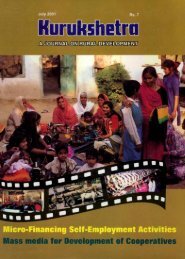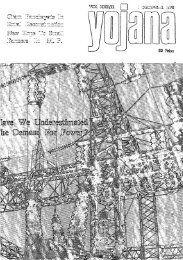Banking - Yojana
Banking - Yojana
Banking - Yojana
- TAGS
- banking
- yojana
- yojana.gov.in
Create successful ePaper yourself
Turn your PDF publications into a flip-book with our unique Google optimized e-Paper software.
Generated by PDFKit.NET Evaluation<br />
•<br />
PERSPECTIVE<br />
<strong>Banking</strong> Secto~ ReforDl in India:<br />
A Study<br />
Anindya Bhukta<br />
The process of strengthening the banking system has to be<br />
viewed as a continuing one. There is no finite end to<br />
improving the levels of efficiency and profitability. Infact,<br />
the situation is one where the system has to cope constantly<br />
with changes in the broader environment in which it<br />
functions and face new challenges that these developments<br />
, impose on it.<br />
FAILURE OF banks was a<br />
regular feature in the preindependence<br />
period and,<br />
though to lesser extent, even in the<br />
post-independence period. The<br />
. banking industry then was mostly<br />
in the h'ands of private<br />
entrepreneurs. As a result<br />
whenever a bank failed its<br />
customers were simply cheated and<br />
their hardearned money was<br />
forfeited. So, nationalisation of<br />
banks was a long-run demand. The<br />
demand finally was satisfied when,<br />
in 1969, though unfortunately<br />
owing to a political compulsion,<br />
the 'government nationalised<br />
fourteen commercial banks.<br />
-rhereafter, in 1980 again, six more<br />
banks were nationalised.<br />
In 1969, the slogan was<br />
introduction of mass-banking. In<br />
fact, prior to this period, private<br />
ban'ks mostly operated in the<br />
urban and semi-urban .areas.<br />
<strong>Banking</strong> facilities were out of reach<br />
of a large number of rural people.<br />
This, in turn, hampered our<br />
savings habits ahd hence<br />
investment. So spread of bank<br />
branches to remote rural areas was<br />
also another need of the hour.<br />
After nationalisation, the<br />
government decided to extend<br />
banking facilities to rural areas.<br />
The 1969-reform of banking<br />
sector got tremendous success in<br />
the sense that there was a<br />
phenomenal growth in the<br />
number of bank branches to reach<br />
every nook and corner of the<br />
country. However, in other senses,<br />
it was a total failure. A review of the<br />
performance of Indian banking<br />
sector in early 90's revealed that<br />
despite the overall progress made<br />
by the banking system in<br />
geographical and functional<br />
coverage, its operational efficiency<br />
had been unsatisfactory,<br />
characterised by low profitability,<br />
high and growing non-performing<br />
assets and relatively low capital base<br />
(Rangarajan, 1999).<br />
Against this background a<br />
programme of reform in the<br />
Indian financial sector was taken<br />
up since 1991. The financial sector<br />
reform is a part of the structural<br />
adjustment programme, initiated<br />
in 1991, basic philosophy of which<br />
is to build a market-led<br />
economy. The financial sector<br />
reform was started in 1991 on the<br />
basis of Narasimham Committee<br />
Report. The committee, headed by<br />
Mr M. Narasimham, submitted its<br />
report in Novem.ber 1991. Though<br />
the report covered the financial<br />
system ofIndia as a whole, its main<br />
thrust was on the banking sector.<br />
The banking sector accounts for 80<br />
percent of the funds flowing<br />
through the financial sector and<br />
hence reform of the banking<br />
,s,ector is considered urgentto build<br />
up a strong and efficient financial<br />
system, which, ir turn, is critical to<br />
the attainment of the goals of<br />
creating a market-driven,<br />
productive and competitive<br />
economy, supporting higher<br />
investment levels and acceri tuating<br />
growth. (Padmanbhan, 1998).<br />
Mr Anindya Bhukta is a Lecturer in Economics, Netaji Mahavidyalaya, Arambagh, Booghly, W. Bengal.<br />
YOJANAJuly 2002 5<br />
Click here to unlock PDFKit.NET






